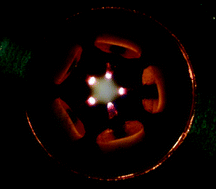A digitally controlled rotating field plasma source for analytical spectrometry
Abstract
A highly flexible technology for constructing plasma sources based on the rotating field concept and the digitally controlled modulation of plasma heating is presented with the plasma source operating at audio and ultrasonic frequency adjustable in the 6–100 kHz range and powered in the 50–250 W range. The device allows for the production of non-stationary plasma discharge sustained by a rotating electric field produced within 5 electrodes positioned in the plane around the axis, while the plasma is temporarily stretched between at least two electrodes. A stable symmetrical low-flow helium discharge is formed at atmospheric pressure operating at total gas consumption of 100–1500 mL min−1 and it is self-igniting. The plasma fundamental parameters can be easily controlled in the wide range including He excitation temperature, OH rotational temperature and electron number density between 2200 and 3300 K, 850 and 1600 K, and 0.6 and 2.0 × 1014 cm−3, respectively. Therefore, the excitation power of the source may be controlled by variations of the pulse width, frequency, commutation mode and gas flow rate. The device is shown to be useful for atomic emission spectrometric determination of

- This article is part of the themed collection: 2012 Winter Conference on Plasma Spectrochemistry, Tucson, Arizona, US

 Please wait while we load your content...
Please wait while we load your content...